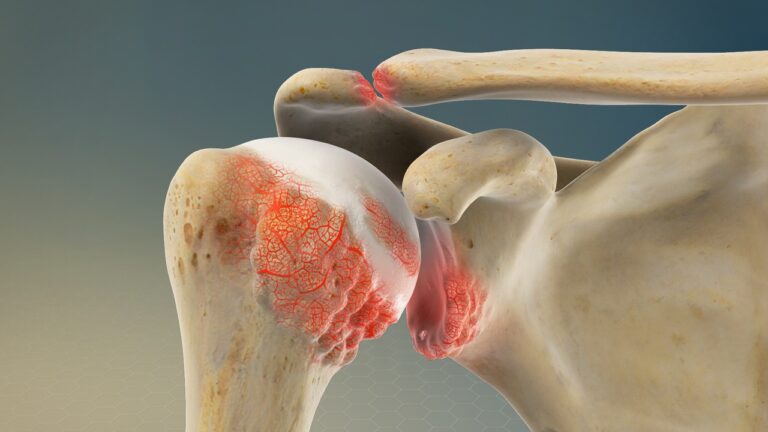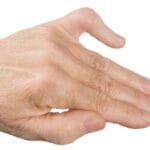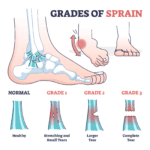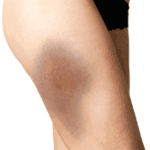Introduction to AC Joint Osteoarthritis
Certain joints in the body are more prone to problems caused by wear and tear. Over time, the cartilage cushioning these joints can deteriorate, leading to a condition known as osteoarthritis or arthrosis.
The acromioclavicular (AC) joint, located in the shoulder, is especially vulnerable to osteoarthritis in middle age. Degeneration of the AC joint often causes pain and limits the ability to perform everyday tasks.
What This Guide Covers
This guide provides insights into:
- The anatomy and function of the AC joint.
- Common causes and symptoms of AC joint osteoarthritis.
- Diagnostic methods and treatment options.
- Rehabilitation strategies to restore function and mobility.
Anatomy of the AC Joint
What is the AC Joint?
The shoulder is made up of three bones:
- Scapula (shoulder blade): Forms the back part of the shoulder.
- Humerus (upper arm bone): Connects the arm to the shoulder.
- Clavicle (collarbone): Links the shoulder to the chest.
The acromion, part of the scapula, extends to form the roof of the shoulder and connects to the clavicle, creating the AC joint.
How the AC Joint Works
- The AC joint allows limited flexibility while connecting the acromion and clavicle.
- Articular cartilage covers the ends of the bones, providing:
- A smooth surface for gliding movements.
- Shock absorption to reduce stress during motion.
Unique Characteristics
Unlike highly mobile joints like the knee or hip, the AC joint moves minimally, shifting slightly to support shoulder motion while maintaining stability.
Causes of AC Joint Osteoarthritis
The AC joint is under constant stress, making it prone to degeneration. Over time, repetitive use and injuries can lead to osteoarthritis.
Common Causes
- Repetitive Shoulder Use
- Activities involving frequent overhead movements, such as weightlifting, place significant stress on the AC joint.
- These activities can accelerate joint degeneration, especially in younger individuals.
- Previous Injuries
- AC Joint Separation:
- Often caused by direct trauma, such as a fall on the shoulder.
- While the joint may heal initially, long-term degeneration can result in osteoarthritis.
- AC Joint Separation:
Symptoms of AC Joint Osteoarthritis
Symptoms of AC joint osteoarthritis typically develop gradually and worsen over time.
Key Symptoms
- Pain and Tenderness:
- Pain begins in the front of the shoulder near the AC joint.
- Discomfort increases when the arm is moved across the chest, compressing the joint.
- Radiating Pain:
- Pain may extend to the shoulder, front of the chest, or neck, making the source harder to pinpoint.
- Visible Changes:
- In previously injured joints, a noticeable bump may appear over the AC joint.
- Clicking or Snapping Sounds:
- The joint may produce sounds during movement due to structural changes.
Diagnosis of AC Joint Osteoarthritis
Diagnosing AC joint osteoarthritis requires a thorough evaluation to confirm the condition and assess its severity.
Steps in Diagnosis
- Medical History:
- Detailed questions about symptoms, daily impact, and past shoulder injuries.
- Pain may be rated on a scale of 1 to 10.
- Physical Examination:
- Tenderness: AC joint tenderness is a common finding.
- Compression Test:
- The arm is gently pulled across the chest to compress the joint.
- Pain during this test suggests AC joint involvement.
- Local Anesthetic Test:
- Injection of a local anesthetic, like lidocaine, into the joint.
- Temporary pain relief confirms the AC joint as the source of discomfort.
- Imaging Tests:
- X-rays: Reveal joint degeneration, such as narrowing spaces and bone spurs.
Treatment Options for AC Joint Osteoarthritis
Treatment aims to reduce pain, restore mobility, and improve function. Approaches include nonsurgical methods and surgical intervention.
Nonsurgical Treatment
- Rest and Anti-Inflammatory Medications:
- Avoid activities that worsen symptoms.
- Use medications like aspirin or ibuprofen to manage pain and inflammation.
- Rehabilitation Program:
- Guided by a physical or occupational therapist, focusing on strengthening and flexibility.
- Cortisone Injections:
- Cortisone, a powerful anti-inflammatory agent, provides temporary but effective pain relief.
Surgical Treatment
Resection Arthroplasty:
- Involves removing the last half-inch of the clavicle to create space between the clavicle and acromion.
- Scar tissue replaces the joint, preventing bone ends from rubbing together while allowing limited movement.
- Approaches include:
- Open Surgery: Performed through a two-inch incision.
- Arthroscopic Surgery: Minimally invasive, using a small camera and tools through tiny incisions.
Rehabilitation After Treatment
Nonsurgical Rehabilitation
- Range-of-Motion Exercises: Begin as pain subsides, focusing on movements below shoulder level.
- Strengthening Program: Strengthen the rotator cuff and shoulder blade muscles to stabilize the joint.
- Home Program: Most patients transition to a home-based program within four to six weeks.
Rehabilitation After Surgery
- Initial Recovery Phase:
- Wear a sling for support and protection.
- Pain and swelling are managed with ice, electrical stimulation, and massage therapy.
- Rehabilitation Timeline:
- Arthroscopic Surgery: Quicker recovery with early range-of-motion exercises and gradual strengthening.
- Open Surgery: Slower recovery, starting with passive exercises at 2–3 weeks and active exercises at 4–6 weeks.
- Advanced Strengthening:
- At six weeks, focus on improving the strength and control of the rotator cuff and shoulder blade muscles.
- Functional Training:
- Exercises mimic work and sports tasks to prepare the shoulder for real-life activities.
Conclusion
AC joint osteoarthritis can often be managed with nonsurgical treatments, but surgical options like resection arthroplasty provide effective solutions for severe cases. Whether through therapy or surgery, a structured rehabilitation program ensures optimal recovery and a return to normal activities.





